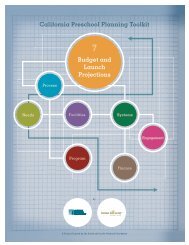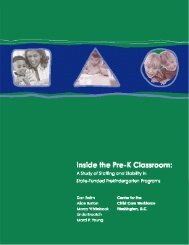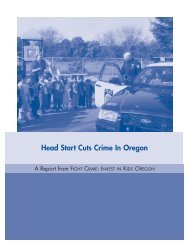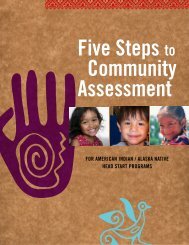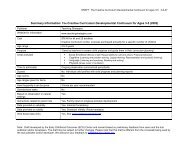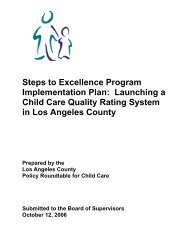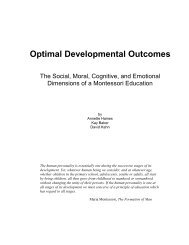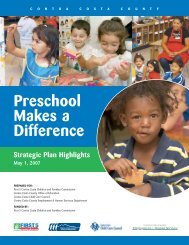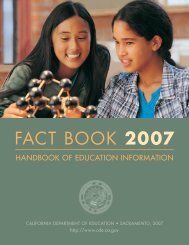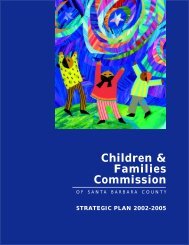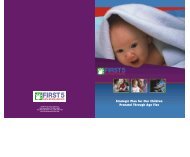Mapping the P-3 Continuum - Foundation for Child Development
Mapping the P-3 Continuum - Foundation for Child Development
Mapping the P-3 Continuum - Foundation for Child Development
You also want an ePaper? Increase the reach of your titles
YUMPU automatically turns print PDFs into web optimized ePapers that Google loves.
Transitions can be considered periods of risk in development. <strong>Child</strong>ren who do not makesuccessful transitions may be at increased risk <strong>for</strong> poor outcomes. For example, research showsthat many school environments are not conducive to adaptive outcomes <strong>for</strong> adolescents. Thetransition from elementary school to junior high or middle school can be a risk period <strong>for</strong>academic decline <strong>for</strong> many youth. 13 The transition from <strong>the</strong> summer to <strong>the</strong> academic year isano<strong>the</strong>r risk period, especially <strong>for</strong> economically disadvantaged children. 14 Whereas <strong>the</strong>re werelittle differences between children in ten low-SES schools as compared to kids in 10 high-SESschools during <strong>the</strong> first grade transition from kindergarten, gaps grew as children got older. Theauthors concluded that this finding was due to “summer loss.” Summer loss is <strong>the</strong> process bywhich children lose skills and in<strong>for</strong>mation learned <strong>the</strong> school year be<strong>for</strong>e, because of <strong>the</strong> lack ofexposure to educationally stimulating activities during <strong>the</strong> summer vacation.In sum, what happens in <strong>the</strong> classroom matters <strong>for</strong> children, and current credentialingrequirements <strong>for</strong> teachers are not necessarily a good indicator of <strong>the</strong> effectiveness of <strong>the</strong>irteaching. Research shows that what happens in <strong>the</strong> classroom does influence cognitive,behavioral, and emotional outcomes. 15 Teacher credentials, on <strong>the</strong> o<strong>the</strong>r hand, were notpredictive of child outcomes. In addition, research shows <strong>the</strong> potential risk that transitionperiods can have <strong>for</strong> children, especially those who are economically disadvantaged.What do we need to know?We still need to know to what extent, and how different classroom contexts influence childoutcomes across ages/grades, and <strong>for</strong> diverse groups of children. We also need to know whatsound teacher preparation looks like and how it is linked with desired child outcomes.IDENTIFY KEY LEVERAGE POINTS AT THE NATIONAL, STATE, AND LOCALLEVELS TO MOVE A P-3 AGENDAParticipants generated a list of key stakeholders <strong>for</strong> P-3:• Higher education institutions who train teachers and administratorso AACTE – American Association of Colleges <strong>for</strong> Teacher Education• National Board <strong>for</strong> Professional Teaching Standards• American Federation of Teachers and National Education Association• NAEYC - National Association <strong>for</strong> <strong>the</strong> Education of Young <strong>Child</strong>ren• CDA – <strong>Child</strong> <strong>Development</strong> Associate• ACCES – Alliance of Community Colleges <strong>for</strong> Electronic Sharing• NASBE – National Association of State Boards of Education• NABE – National Association <strong>for</strong> Bilingual Education• NGA – National Governors Association13 Zaslow, M. (2003). What can we learn from developmental research about how to support children’s learningfrom age three to age eight? Presentation <strong>Foundation</strong> <strong>for</strong> <strong>Child</strong> <strong>Development</strong>14 Zaslow, M. (2003). What can we learn from developmental research about how to support children’s learningfrom age three to age eight? Presentation <strong>Foundation</strong> <strong>for</strong> <strong>Child</strong> <strong>Development</strong>15 Pianta, R. (2003). Standardized classroom observations from pre-k to 3 rd grade: A mechanism <strong>for</strong> improvingaccess to consistently high quality classroom experiences and practices during <strong>the</strong> P-3 years. A <strong>Foundation</strong> <strong>for</strong><strong>Child</strong> <strong>Development</strong> working paper11



